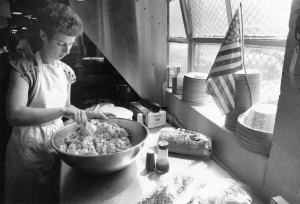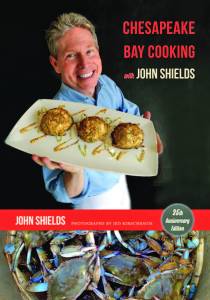Guest post by John Shields
A highlight of the Baltimore Book Festival this weekend will surely be chef John Shields’ discussion of his charming new book from JHU Press, Chesapeake Bay Cooking with John Shields, 25th anniversary edition (on Saturday at 12:30 p.m., at the Food for Though Stage). And if you have any doubts as to his qualifications to be the one-and-only “Mr. Crabcake,” read this wonderful excerpt from his book.
Paris may have its foie gras, New Orleans its gumbo, and Spain its paella, but the folks living along the shores and far-reaching tributaries of the Chesapeake Bay have their own signature dish: the crab cake. No dish is more closely associated with the Chesapeake and the blue crab than the mighty crab cake.
When asked to describe their aquatic culinary prize, locals are hard-pressed to come up with a concise description. “Well, hon, it ain’t a confection, and you don’t normally bake them, and sure ain’t a dee-sert . . . naa . . . it’s not exactly made in a cake pan either . . . well . . . oh hell, it’s more like a ball of crab all spiced up and fried.”
Now the crab cake may well be a unifying source of fierce regional pride, but its many recipes produce more squabbling, feuding, and heated family debates than either the local ball club or politics. Tucked away in each family’s archives is The Crab Cake Recipe. It is the only one; it is the best; and all the others are wrong. Period. I’ve witnessed barroom brawls over which restaurant or tavern serves the best crab cake. Research on the ubiquitous cake provides tremendous pleasure for the stomach, but is, all in all, a dangerous business.
 The Chesapeake crab cake has been a staple of the local diet dating back to at least the sixteenth century. Crab cakes were made by local Indian women who mixed the crabmeat with herbs, vegetables, and cornmeal, forming them into small cakes that were fried in sizzling hot bear fat. They were called “cakes of crab.” The preparation technique has changed only slightly over the centuries, with the exception that bear fat is not used for frying these days.
The Chesapeake crab cake has been a staple of the local diet dating back to at least the sixteenth century. Crab cakes were made by local Indian women who mixed the crabmeat with herbs, vegetables, and cornmeal, forming them into small cakes that were fried in sizzling hot bear fat. They were called “cakes of crab.” The preparation technique has changed only slightly over the centuries, with the exception that bear fat is not used for frying these days.
What remains true of Bay crab cakes today is that different regions of the Chesapeake have their own style of cakes. On the Eastern Shore folks prefer their crab cakes prepared simply so that the flavor of the crab is allowed to shine through. This happens by moistening the crab just slightly with lemon butter and adding virtually no filler, or what locals sometimes refer to as “sawdust.” Since there is little binding to hold the cakes together they must be broiled and handled with great care. The end result for a crab purist is sheer bliss: an absolutely pure, unadulterated crab cake. Folks from other parts of the Bay, particularly near the big cities, scoff at this notion and find these cakes bland. They prefer the style of cake that is flavored by a spicy, mayonnaise-enriched batter with a bread or cracker binding. The cake is then either fried or broiled. A third version of a crab cake, which is common in the southern parts of the Bay, is made by using a lightly seasoned cream sauce to hold the crabmeat together. The cakes are then chilled to firm them up and later lightly coated in bread crumbs and lightly fried. There are crab cake recipes for a full spectrum of tastes, yet people continue to experiment and discover even more.
Now, what’s all the fuss about? They’re just little balls of crab all mushed together, right? Wrong. Here’s a guide to the structural makeup of a crab cake.
Choosing Crabmeat for Crab Cakes
This is like choosing a pet. Should it have a fancy pedigree or be a mixed breed? This all depends on your tastes and, in some cases, your wallet. The crab cake dishes in this book list the crabmeat grade the recipe’s originator believes works best, but feel free to substitute any type of crabmeat.
Jumbo Lump Crabmeat is what purists generally insist on and is the very best that money can buy. Crab cakes made with all jumbo lump are best sautéed or broiled rather than deep-fried. These big, beautiful lumps, with absolutely no shell or cartilage, come from the backfin on either side of the crab. In the old days of the crab business this type of crabmeat was aptly known as “backfin.”
Lump Crabmeat is a bit of a misnomer and is actually a blend of one-third jumbo lump and two-thirds flake (smaller pieces of crab from the chambers of the body). This type of crabmeat makes a beautiful cake of large, delectable lumps of crab combined with flavorful body meat. Just a touch of binding holds the lump cake together nicely. This meat is perfect for any style crab cake you may wish to prepare.
Backfin Crabmeat is all flake from the center body cavity of the crab. While it does not make a particularly nice crab cake on its own, it works quite well when mixed with jumbo lump or lump. Higher in shell content than jumbo lump and lump, this type requires careful picking over to remove small bits of cartilage. It’s a great way to bring the price of the crab cake down and still produce a high-quality crab cake and make the family proud.
Claw Meat provides dark, sweet meat and a less expensive crab cake. These cakes, while not regarded as top of the line, are what are served in many coffee shops and neighborhood taverns, as well as at local fairs and carnivals. They are quite tasty and economical for large gatherings and parties. Crab cakes made with claw are generally fried and have a wonderful crispy outside with a delightful flavor from the sweet meat. Claw meat tends to have a higher moisture content, which requires a tad more binding to hold the cakes together. Most locals use claw meat in their vegetable crab soups as well.
Mixed Cakes are made from a blend of two or more types of crabmeat. My favorite mix is half jumbo lump and half lump, but actually any combination will work. Try your own formulas to find what you like best.
Meet John at the Baltimore Book Festival at 12:30 p.m. on Saturday at the Food for Thought Stage. Or stop by Gertrude’s to pick up your signed copy.
Read Wednesday’s blog post for more information on where to find the JHU Press at this year’s Baltimore Book Festival.


